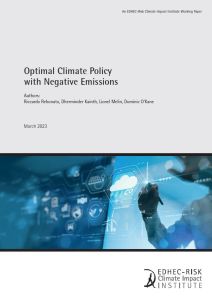

Optimal Climate Policy with Negative Emissions
We can limit the future temperature impact of climate change in two ways:
- reducing our use of CO2 emitting ...
Author(s):
Summary:
We can limit the future temperature impact of climate change in two ways:
- reducing our use of CO2 emitting fuels as an energy source (abatement), and
- using negative emission technologies (NETs) to remove existing CO2 from the atmosphere (removal).
Using a modification of the DICE model, authors analyse the optimal use of these two policy responses to climate change. After calibrating the marginal costs of abatement and CO2 removal to the latest scientific information, they find that carbon removal must play a very important role in an optimal policy.
If this policy is followed, they find that theParis-Agreement 1.5-2 C warming by 2100 target is not just aspirational, but optimal.
When an important role is played by NETs to control global warming, the decrease in carbon emissions can be more gradual, reducing transition risk and social dislocations. they examine the impact on the economy of large-scale carbon removal programmes, the potential for moral hazard and the logistic problems associated with the storage of the removed carbon.
Register to download PDF
Register/Log in| Type : | EDHEC Publication |
|---|---|
| Date : | 11/04/2023 |

